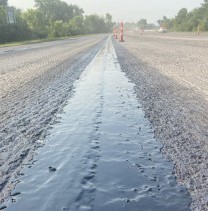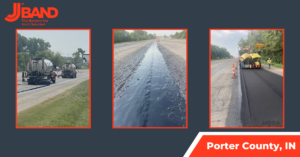Used since 2002 and now across 19 states, J-Band has a proven track record of delivering longer road life, while also offering an impressive return on investment. Developed at the laboratories of Heritage Research Group, J-Band is applied during the road construction process just below the final layer of asphalt pavement. Once covered, it migrates upwards filling the voids that can be penetrated by water and air, preventing damage before it can start. Asphalt Material’s J-Band product is a void reducing asphalt membrane (VRAM).
This particular project took place in July of 2021 in northern Indiana. The 96,544–foot project runs from US 12 to SR 130. The J-Band application began early in the morning and the application was scheduled to be 18” wide and 1.51 lb./ft for the 2” surface. This was over a recently milled surface mix that was tacked at the centerline. The ambient temperature was 75°F; the pavement temperature was 90°F. The average width of VRAM applied was measured at 18 in.
EDITOR’S NOTE:
Depending on the specifications in each state, there may be an upper limit on temperature. In addition, width and application rates are also specified. Measures should be taken in all cases to ensure compliance with specifications.
Photos from the project can be viewed below.
EDITOR’S NOTE:
In every state except Illinois, the product is specified as VRAM or Void Reducing Asphalt Membrane. However, in Illinois the product is specified as LJS or Longitudinal Joint Sealant. The VRAM product from Asphalt Materials is called J-Band and was created in the labs of The Heritage Research Group.
In every state except Illinois, the product is specified as VRAM or Void Reducing Asphalt Membrane. However, in Illinois the product is specified as LJS or Longitudinal Joint Sealant. The VRAM product from Asphalt Materials is called J-Band and was created in the labs of The Heritage Research Group.


